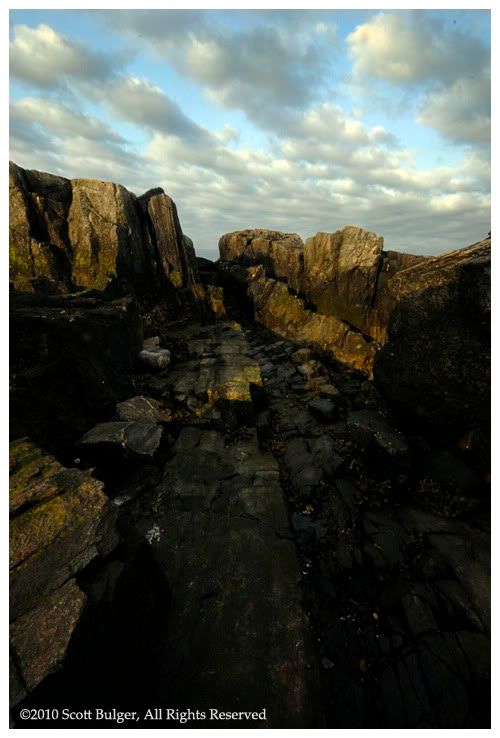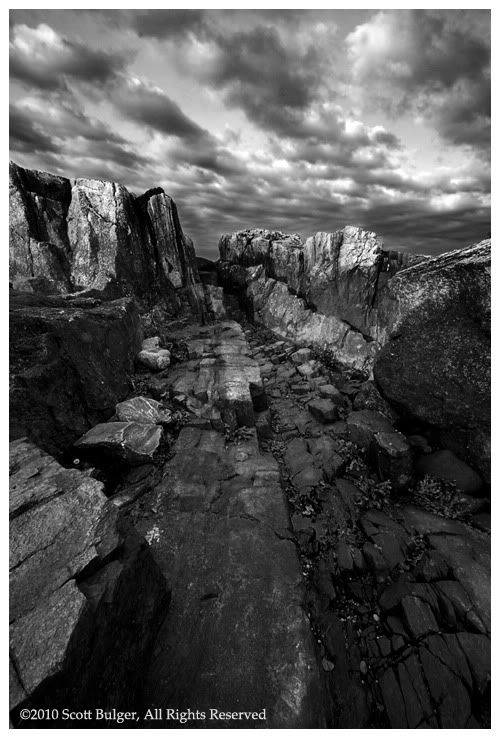What do you SEE?
"When you're holding your camera and peering through the viewfinder, what is it that you see?"
I'm repeatedly asked this question (or some variant of it) by students and viewers of my work, all wondering how I get from what I'm looking at, to what I see. Since I work almost exclusively in black and white, my finished images are always significantly different than what is actually in front of me.
Pre-visualization. Visualize the scene in front of you as it is going to be when you are done, not as it appears in front of you. It's much easier to get to your destination if you know where you are going. If you don't have a specific destination, it's too easy to get sidetracked or end up someplace good, but not great. Once you know what you want a given scene to look like, then go about planning on how to get it there.
This is what was in my viewfinder when I set up the camera on the tripod.
I'm repeatedly asked this question (or some variant of it) by students and viewers of my work, all wondering how I get from what I'm looking at, to what I see. Since I work almost exclusively in black and white, my finished images are always significantly different than what is actually in front of me.
Pre-visualization. Visualize the scene in front of you as it is going to be when you are done, not as it appears in front of you. It's much easier to get to your destination if you know where you are going. If you don't have a specific destination, it's too easy to get sidetracked or end up someplace good, but not great. Once you know what you want a given scene to look like, then go about planning on how to get it there.
This is what was in my viewfinder when I set up the camera on the tripod.

This is what I have in my mind BEFORE I ever trip the shutter.

Don't rely on happy accidents to create a beautiful image. Be meticulous in your planning.
- Know where the light is and the effect it's going to have on your subject. Don't go out at high noon on a cloudless day and complain about the shadows and the unbearable contrast. Set your alarm clock and get out of bed while it's still dark if necessary.
- Choose the appropriate lens to gain the point of view, proportions, and relationships between objects that you are attempting to obtain.
- Get your camera off of "Automatic". Take control of both your shutter speed and your aperture.
- Choose the appropriate aperture to get the depth of field that you want, and combine that with a shutter speed that will control any motion in your image and have it displayed the way you want it. Your options can be limited here either by your equipment or by the current lighting conditions.
- Use your ISO setting and/or neutral density filters to compensate your exposure. It's not just a simple nod to reciprocity anymore.
- Bracket your exposures. The better exposure you start with, the easier it is going to be to get to your destination.
- Understand what post-processing you are going to be able to do and how it will affect your image. We aren't talking about HDR here, just some levels, curves, dodging, and burning. Simple darkroom techniques.
So know where you want to go, and know how you are going to get there. It makes it a much nicer ride when you safely arrive at your destination.


3 comments:
LOve it. I don't get to do as much photography these days, as I would like. I am the same way with planning what I see and making it happen. YOu have to relate the image to the everyday and translate the image to what you are seeing through your viewfinder. Very Nice.
I like seeing examples of the original photo and then the final product. It reminds me that some photos can be enhanced or cropped to improve the overall balance of a photo.
My biggist problem is getting up before the crack of dawn to get some of the best light of the day.
Lovely end result Scott.
That's great comparison of 'what you see is not what you get' ;)
WOW-factor (how often ppl say 'WOW! :))) of the second is many times higher :D
Post a Comment